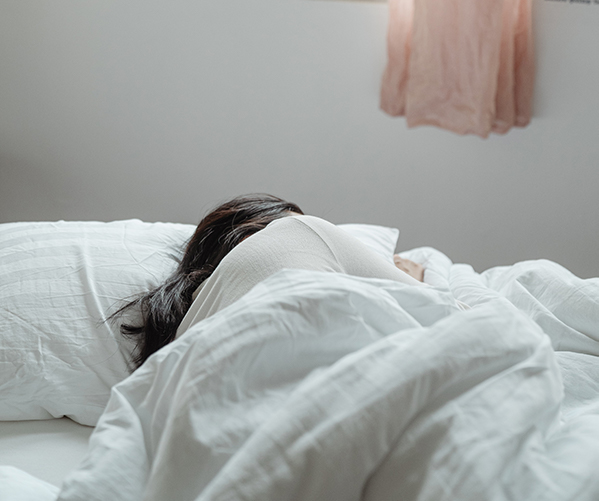
When kids and teens are anxious at bedtime it’s perhaps the most challenging time of the day for us, as parents, to respond in ways that are helpful. We’re tired ourselves, and the anxiety our kids are feeling often quickly rubs off onto us. In the evenings, it’s worth remembering that levels of serotonin in the brain are falling as the sleep hormone melatonin rises in preparation for us to hit the hay too. The combination of tiredness, frustration and reduced serotonin can, at times, make for impatient responses to our kids that wind everyone up instead of down. It’s not easy!
So, what to do instead when your anxious child or teen can’t sleep? Such an important question, knowing how closely connected sleep and anxiety are. When anxiety is climbing, or high, it makes falling asleep difficult. And rightly so. The anxiety response is protective in the presence of a threat and falling asleep under threat is not going to bode well for survival. Makes sense, right? The other challenge is that reduced sleep increases our sensitivity to threat, making us more likely to feel anxious.
It’s an important cycle to break but one that might take some time, and that’s okay. Consider every day a new opportunity to support your child or teen to get a little more pillow time. Every little bit helps. Here are five ideas to promote sleep when your child/ren or teens are feeling anxious.
- Make time to talk before heads hit the pillow
When the day is done and little (or ‘big’) heads hit the pillow at night it’s a time when events of the day often come to mind. If something upsetting, unusual or worrying has happened during the day, bedtime might be the first time you hear about it. As the event is relived and shared there’s potential for anxiety to rise, right when sleepy kids need their rest. If you include a lovely chat earlier in the evening as part of the bedtime routine, there’s been ample opportunity to talk through what’s happened and for residual stress and anxiety to settle before the lights go out.
- Take the pressure off falling asleep
If anxious children and teens have been having trouble falling asleep, they can become anxious about sleep itself. One way to help combat this is to take the pressure right off by saying “it doesn’t matter if you don’t fall asleep, your body and brain are resting whether you’re asleep or not.” Removing any expectation of if-and-when they’re going to fall asleep removes another potential ‘threat’ that can build bedtime anxiety.
- Storytime, reading and audiobooks
For younger kids story time is a beautiful way to help settle their anxious minds before sleep. Once the story is over you might like to open a discussion about one of the characters and what could happen next – it doesn’t matter if the story is over, there are endless possibilities for every character which engage otherwise potentially anxious minds in curiosity and creativity. For older kids reading is relaxing as is listening to an audio book after the lights go out. Each of these strategies helps tired and anxious kids better manage their attention.
- Teach your child and teen about anxiety
Feeling anxious feels awful. As the brain and body prepare to fight a foe or flee a dangerous situation, a myriad of things are happening. They might feel a sense of dread or get an upset tummy, they might feel teary or angry or worried. Without an understanding of what’s happening, the anxiety response itself can cause more anxiety. And we know what that means for sleep. Forget it. But when anxious kids learn how to identify the way they feel as anxiety is rising, they’re able to recognise it for what it is and start to put strategies in place to manage it.
- Teach a relaxation technique
Teaching relaxation techniques to our kids can make a significant difference at bedtime, and during other stressful encounters they’re sure to have during waking hours from time to time. An effective technique to teach is square breathing. It’s simple to remember and easy to do. A square has 4 sides, and this technique has 4 parts. As your child or teen imagines drawing (or draws in the air) the top edge of a square, they breathe in. The first vertical side of the square is where they hold their breath. As they draw the bottom edge of the square they breathe out, and then once again hold their breath as they complete the square with the last vertical line. Then repeat for a series of cycles. As your child becomes more adept at this encourage them to extend the length of time they breathe in, hold, breathe out and hold. After several cycles invite your child to notice any differences in how they feel. Connecting them with the feelings of relaxation and reduced anxiety that follow help reinforce the use of this very effective technique.
If anxiety at bedtime is becoming more of a challenge over time and not less, there are a number of avenues you can pursue. For many children a calm and consistent evening routine, devices off in the hour leading to lights out, calm and helpful conversations about fears and worries, the use of a transition toy or blanket to comfort younger kids and progressive step laddering of time in bed versus time with mum and dad at night can all make a meaningful difference. If you’re in need of extra support chat to your family doctor for professional advice on the next steps that best meet the needs of your family.
For other practical strategies to manage anxiety, check out my books Anxious Kids and Anxious Mums here.

share the love
[Sassy_Social_Share]

about
Jodi is on a mission to elevate mental health and wellbeing in families, classrooms and workplaces.


free 5-day
Calm your anxious brain
mini course

Recent Posts

free 5-day
Calm your anxious brain
mini course
Sign up for my free 5-day ‘Calm Your Anxious Brain’ email mini-course. Put the strategies into place for yourself, light the way for your kids, or do both.






